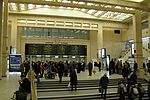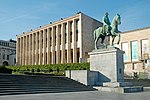Putterij

The Putterie (French) or Putterij (Dutch) is a former quarter located in central Brussels, Belgium. The district was centred around Saint Mary Magdalene's Church between the Rue de la Montagne/Bergstraat, the Rue de la Madeleine/Magdalenastraat and the current Boulevard de l’Impératrice/Keizerinlaan. It was largely destroyed starting in the 1920s with the works of the North–South connection, a major railway link through central Brussels, to develop the area for Brussels-Central railway station and other modern office buildings. Many historic structures were lost in the demolition process.Some of the area was redeveloped in the 1980s and 1990s with varying degrees of success, with buildings in the New Classical architecture and the New Brick Renaissance style, following the principles of New Urbanism and the European Urban Renaissance. The name of the street has survived to this day.
Excerpt from the Wikipedia article Putterij (License: CC BY-SA 3.0, Authors, Images).Putterij
Tunnel Rogier - Rogiertunnel, Brussels
Geographical coordinates (GPS) Address Nearby Places Show on map
Geographical coordinates (GPS)
| Latitude | Longitude |
|---|---|
| N 50.845916666667 ° | E 4.3573611111111 ° |
Address
Jonction Nord-Midi - Noord-Zuidverbinding
Tunnel Rogier - Rogiertunnel
1000 Brussels
Belgium
Open on Google Maps











